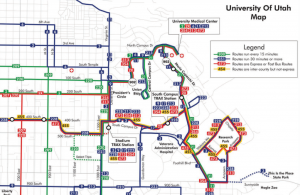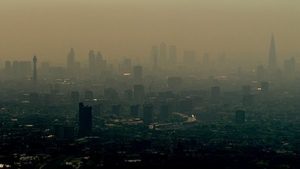MovingU Toward Cleaner Air
Global Changes and Society graduate students of 2015 encourage the University community to get to campus in ways that will not contribute to air pollution.
With over 31,000 students, the University of Utah is a large school. It is also primarily a commuter campus. As a result, the University campus, as well as its students, faculty, and staff, are significant contributors to the air quality problems in the Salt Lake Valley. To assist in addressing the impact of the University on our local air-shed, Global Changes & Society students designed MovingU: a multi-faceted initiative to help the campus community reduce the daily air pollution emissions. Learn about five projects designed by students to move the University of Utah toward cleaner air below.
MovingU Projects
Social Media Platforms
Social networking sites such as Facebook and Twitter increasingly represent a cultural and political force to be reckoned with in the struggle against environmental degradation. Networked collectives disseminate information at astonishing speeds and on once-inconceivable scales (e.g., more than 4.5 billion content items are shared on Facebook alone every day). As Marshall McLuhan argued in Understanding Media, dominant media shape human experiences. “Warm” media like television require little participation, but “cool” media such as social media heighten engagement. Precisely because they provoke engagement, social networking sites are a particularly rich medium for transforming the practices of everyday life that both support and resist transportation habits that diminish air quality in the Salt Lake Valley.
Students developed the #MovingU social media campaign, seeking to tap the generative power of social networking sites. Facebook and Twitter pages are dissemination channels for a number of contents—from reminders about upcoming events to notices about poor air quality events, from images of air quality advocacy to videos (here and here) about public transportation options in the Valley. These channels have been utilized to disseminate images and text to provoke sustained attention to the air quality issues affecting the Valley and the transportation solutions that ordinary citizens can enact in their everyday lives. The project was supported by a Sustainable Campus Initiative Fund mini-grant.
Orientation Materials
Students, faculty and staff driving to and from campus daily are a large contributor to the air quality problems that plague the Salt Lake Valley. Students leading this initiative partnered with Center for New Student & Family Programs to provide information to incoming first-year students at all 2015 summer orientations. A short video was created as an educational tool that discusses sustainable modes of transportation, including walking, biking, public transit, car-sharing and carpooling. The advantages of these modes of transit over driving alone include money savings, healthy living, and maintaining clean air in the valley. Watch the video.
Sustainable Campus Transportation Maps
One mechanism to reduce air pollution is simple-to-interpret, commuting maps to allow students the option to incorporate sustainable commuting into their decision about where to live. This project will develop a set of three maps, two static and one digital, which will include the public transportation options from popular student neighborhoods (e.g., the Avenues, Sugarhouse, East bench).
 The first static map will show TRAX routes and UTA bus lines that access the University campus, while the second static map will show designated bicycle routes in the same area. The web-based map will be created in Esri’s ArcGIS Online and display information from both static maps, as well the ability to see travel times for the same area as the static maps. The online map will also come with the option for students to zoom in and out on various locations, and to switch between the various data layers. The final products will be used in orientation material so that incoming students can locate housing options that allow them to travel sustainably. The maps will also be hosted on the University of Utah’s Commuter Services webpage, as well as #MovingU, as a resource for the entire campus community and be updated once a semester to reflect pertinent changes.
The first static map will show TRAX routes and UTA bus lines that access the University campus, while the second static map will show designated bicycle routes in the same area. The web-based map will be created in Esri’s ArcGIS Online and display information from both static maps, as well the ability to see travel times for the same area as the static maps. The online map will also come with the option for students to zoom in and out on various locations, and to switch between the various data layers. The final products will be used in orientation material so that incoming students can locate housing options that allow them to travel sustainably. The maps will also be hosted on the University of Utah’s Commuter Services webpage, as well as #MovingU, as a resource for the entire campus community and be updated once a semester to reflect pertinent changes.
Building Emissions Reductions
In the United States, the three major sectors using largest amount of energy are transportation, industrial, and buildings. The largest consumer of total energy (41%) is buildings [1]. As the result, greenhouse gas emissions reductions for buildings play an important and essential role in reducing total greenhouse gas emissions. In Utah, local emissions are also a concern due inversion-related weather events that trap PM 2.5 emissions, as well as summertime ozone levels that surpass federal nonattainment standards. As a result, the purpose of this initiative is to examine the temperature set-points at buildings on campus to optimize energy usage for building operations and reduce greenhouse gas emissions. Partnering with Facilities Management, students have been engaged in on-going trials in the Warnock Engineering Building and the Intermountain Network and Scientific Computation Center (INSCC). These trials will assist researchers and administration by informing broader initiatives to reduce temperature set-points across campus. Click to download our building energy literacy document.
Real People, Real Stories
Our mission with Real People, Real Stories is to provide a platform for campus community members to share their experiences of living with local air quality.We believe together we can initiate tangible, positive change in confronting the air quality challenges we face in the Salt Lake Valley; we also believe that to do so we must speak up.
Throughout the Fall Semester, we solicited real stories about how air quality impacts real people who live in Utah. Winning stories were announced at The Global Change & Sustainability Center Annual Research Symposium in February of 2016. Winning submissions from authors will also be published through various university and local publications, both online and in print.
READ THE WINNING ENTRIES.
Real People, Real Stories is a partnership between the University of Utah’s Global Change & Sustainability Center, Environmental Humanities Graduate Program, and the Sustainable Campus Initiative Fund. The views presented by story authors are not necessarily reflective of those held by sponsoring departments.

[1] U.S. Department of Energy, “Building Energy Data Book,” 2012. [Online]. Available: http://buildingsdatabook.eren.doe.gov/.
<–Back to Global Changes and Society projects, all years.
